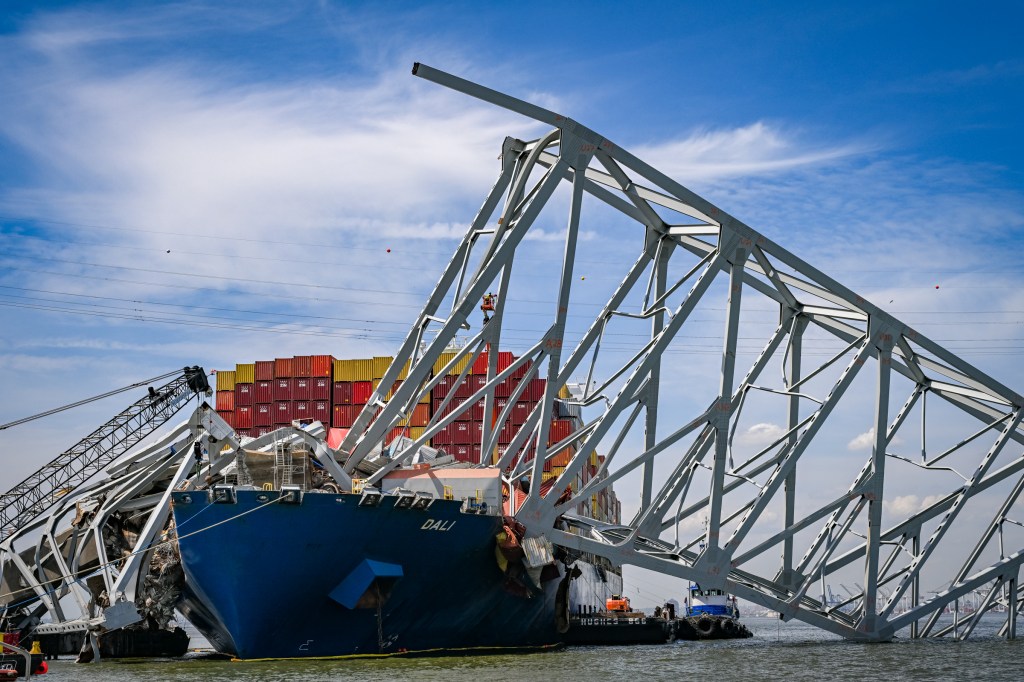Underwood Energy regularly shipped propane gas and heating oil over the Francis Scott Key Bridge before it collapsed, but is now forced to make a “30-mile detour” after the container ship Dali caused the bridge to collapse on March 26. The resulting “lost profits and loss of business” is at the heart of new federal filings the energy supplier made on Tuesday.
Such hazardous materials are not permitted through tunnels under Maryland ports due to safety hazards, meaning the collapse of the Key Bridge eliminates the only harbor crossing through which such materials can be transported.
The Dali’s Singaporean owners and managers, Grace Ocean Pvt. Ltd. and Synergy Marine Group, respectively, are seeking to limit their liability in the disaster, but the propane gas distributors argue their liability should not be limited — rather, it should be “made an example” of the ship’s owner and operator, the lawsuit states.
Underwood, which says on its website it provides propane gas, HVAC, plumbing and mechanical services to the Washington, D.C., Maryland and Virginia areas, said its “small business” is “hindered by this national disaster.” The company said the Dali is an “unseaworthy” vessel and that its owners and operators are “negligent.”
“The collision with Key Bridge was foreseeable and avoidable and was a direct and proximate result of Petitioner’s carelessness, negligence, gross negligence and recklessness and the unseaworthiness of the Dali,” the lawsuit states.
Darrell Wilson, a spokesman for Grace Ocean and Synergy, declined to comment on the allegations.
“Unfortunately, due to the ongoing investigation and legal proceedings in which we are fully involved, it would be inappropriate to comment at this time,” he said in a statement.
Underwood’s attorney, Brian Short, said his client operates a rail yard in Sparrows Point. The oil is transported to Underwood by rail car and then distributed by truck to customers, Short said in an interview Tuesday.
“All of his customers are on the other side of the bridge,” Short said. “He sells heating oil, and he can’t ship it through the tunnel, so this is a huge problem for his small business.”
Short called the heating fuel industry a “cutthroat business” and said his clients are currently at a significant disadvantage compared to their competitors.
“Oil from here is the same as oil from there. It’s a very low margin business. When you get shoved out like that, it’s very hard to compete,” he said.
While the Dali lost power twice in the shadow of the Key Bridge on March 26, crashed into one of the bridge’s key supports and nearly became adrift, the lawsuits filed so far against Underwood, Synergy and Grace Ocean focus on what happened before the giant cargo ship left the Port of Baltimore’s Sea Girt Marine Terminal.
Federal investigators from the National Transportation Safety Board determined that the Dali lost power twice about 10 hours before it set sail for Sri Lanka.
A blackout, or complete loss of power, in port prompted the crew to switch a breaker on the ship’s electrical system, according to the NTSB’s preliminary investigation report. After the 984-foot-long Dali set sail in the early morning hours of March 26, the replaced breaker tripped, causing the first of two complete power losses within about a half-mile of the bridge.
Investigators recently narrowed their search to an electrical component the diameter of a soda can, and the NTSB has invited representatives from the ship’s manufacturer, South Korea’s Hyundai, to analyze the device.
Less than a week after the bridge collapsed, the companies that own and manage the Dali filed a lawsuit under a 19th century federal law, seeking to absolve themselves of liability and limit potential damages related to the collapse to the ship’s remaining value and revenue from its cargo, estimated at $43.7 million.
In the weeks and months after the collapse, workers searched for the bodies of six construction workers who fell to their deaths into the Patapsco River, then removed the collapsed bridge and tons of highway debris from the murky water. Those rescue efforts cost hundreds of millions of dollars, and officials estimate it will cost at least $1.7 billion to rebuild the bridge.
Maryland and federal authorities have pledged to hold Dali’s owners and managers accountable as they respond to the disaster.
Baltimore’s mayor and city council quickly alleged negligence on the part of the companies behind the Dali, alleging in court filings that they allowed an unseaworthy vessel to leave Baltimore harbor. Other companies, including Baltimore publishing companies, followed suit with similar legal claims.
The law that Synergy and Grace Ocean sued to protect themselves, the Limitation of Liability Act of 1851, has come under scrutiny in the aftermath of the Key Bridge collapse, with some federal lawmakers arguing the law, designed to protect the shipping industry, is outdated and promising an overhaul.
Democratic Reps. John Garamendi and Hank Johnson of California and Georgia introduced a bill in August that would retroactively increase liability rates for foreign vessels from the day before the bridge collapse, potentially making the companies behind the Dali liable for up to $854 million.
Baltimore Sun reporter Madeline O’Neill contributed to this report.



